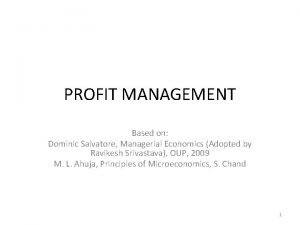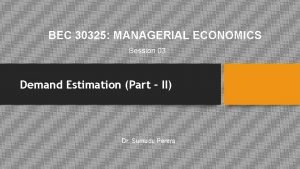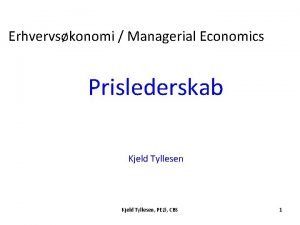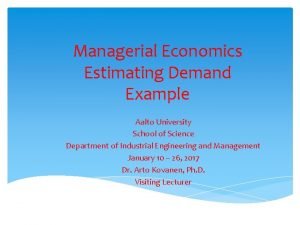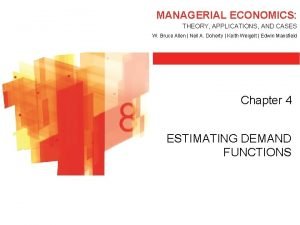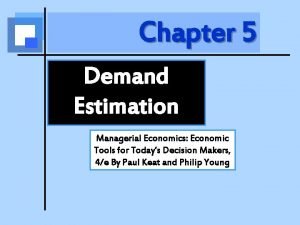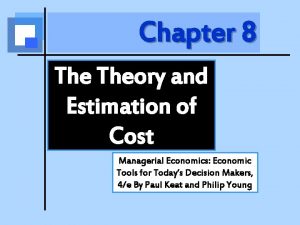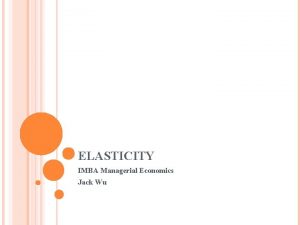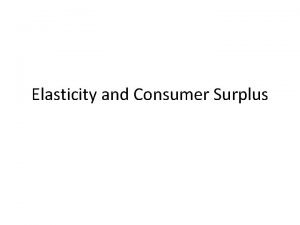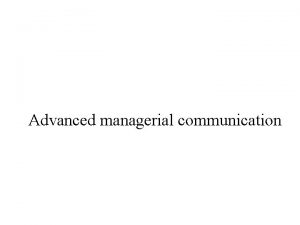Managerial Economics Elasticity 1 Elasticity A measure of


















- Slides: 18

Managerial Economics Elasticity 1

Elasticity ¡ A measure of the responsiveness of one variable to changes in another variable ¡ It is the percentage change in one variable that arises due to a given percentage change in another variable. ¡ The elasticity measure does not depend on the units in which we measure the variables. 2

Own Price Elasticity of Demand ¡ Own price elasticity: A measure of the responsiveness of the quantity demanded of a good to a change in the price of that good; Demand is elastic if the absolute value of the own price elasticity is greater than 1. Demand is inelastic if the absolute value of the own price elasticity is less than 1. Demand is unitary elastic if the absolute value of the own price elasticity is equal to 1. 3

Elasticity and Total Revenue ¡ If demand is elastic, an increase (decrease) in price will lead to a decrease (increase) in total revenue. ¡ If demand is inelastic, an increase (decrease) in price will lead to an increase (decrease) in total revenue. ¡ Total revenue is maximized at the point where demand is unitary elastic. 4

Factors Affecting the Own Price Elasticity ¡ Available substitutes The more substitutes available for the good, the more elastic the demand for it. A price increase leads consumers to substitute toward another product, thus reducing considerably the quantity demanded of the good. When there are few close substitutes, demand tends to be relatively inelastic . ¡ Time Demand tends to be more inelastic in the short term than in the long term. The more time consumers have to react to a price change, the more elastic the demand for the good. Time allows the consumer to seek out available substitutes ¡ Expenditure share Goods that comprise a relatively small share of consumers’ budgets tend to be more inelastic than goods for which consumers spend a sizable portion of their incomes. 5

Selected Own Price Elasticities Market Own Price Elasticity Transportation -0. 6 Motor Vehicles -1. 4 Motorcycles and bicycles -2. 3 Food -0. 7 Cereal -1. 5 Clothing -0. 9 Women’s clothing -1. 2 6

Selected Short- and Long-Term Own Price Elasticities Market Transportation Short-Term Own Long-Term Own Price Elasticity -0. 6 -1. 9 Food -0. 7 -2. 3 Alcohol and tobacco Recreation -0. 3 -0. 9 -1. 1 -3. 5 Clothing -0. 9 -2. 9 7

Cross-Price Elasticity ¡ Cross-price elasticity: A measure of the responsiveness of the demand for a good to changes in the price of a related good; the percentage change in the quantity demanded of one good divided by the percentage change in the price of a related good. ¡ The cross-price elasticity is positive whenever goods are substitutes. ¡ The cross-price elasticity is negative whenever goods are complements. 8

Income Elasticity ¡ Income elasticity: A measure of the responsiveness of the demand for a good to changes in consumer income; the percentage change in quantity demanded divided by the percentage change in income. ¡ The income elasticity is positive whenever the good is a normal good. ¡ The income elasticity is negative whenever the good is an inferior good. 9

Advertising Elasticity ¡ The own advertising elasticity of demand for good X defines the percentage change in the consumption of X that results from a given percentage change in advertising spent on X. 10

Selected Long-Term Advertising Elasticities Long-Term Advertising Elasticity Clothing 0. 04 Recreation 0. 25 11

12

Example ¡ The demand for personal computers can be characterized by the following point elasticities: price elasticity =-5, cross-price elasticity with software=-4, and income elasticity=2. 5. Indicate whether each of the following statement is true or false. A price reduction for personal computers will increase both the number of units demanded and total revenue of sellers. The cross-price elasticity indicates that a 5% reduction in the price of personal computers will cause a 20% increase in software demand. Demand for personal computers is price elastic and computers are cyclical normal goods. Falling software prices will increase revenues received by sellers of both computers and software. A 2% price reduction would be necessary to overcome the effects of a 1% decline in income. 13

Example L. L. Bean is a catalog retailer of a wide variety of sporting goods and recreational products. Although the market response to the company's spring catalog was generally good, sales of L. L. Bean's $140 deluxe garment bag declined from 10000 and 4800 units. During this period, a competitor offered a whopping $52 off its regular $137 price on deluxe garment bags. Calculate the arc cross-price elasticity of demand for L. L. Bean's deluxe garment bag. L. L. Bean's deluxe garment bag sales recovered from 4800 units to 6000 units following a price reduction to $130 per unit. Calculate L. L. Bean's arc price elasticity of demand for this product. Assuming the same arc price elasticity of demand calculated in part b, determine the further price reduction necessary for L. L. Bean to fully recover lost sales (i. e. , regain a volume of 10000 units). 14

Example ¡ Enchantment Cosmetics Inc. offered a list of cosmetic and perfume products marketed through leading department stores. Product Manager recently raised the suggested retail price on a popular line of mascara products from 9 euro to 12 euro following increases in the cost of labor and materials. Unfortunately, sales dropped sharply form 16200 to 9000 units per month. In an effort to regain lost sales, Enchantment ran a coupon promotion featuring 5 euro off the new regular price. Coupon printing and distribution costs totaled 500 euro per month and represented a substantial increase over the typical advertising budget of 3250 euro per month. Despite these added costs, the promotion was judged to be a success, as in proved to be highly popular with consumers. In the period prior to expiration, coupons were used on 40% of all purchases and monthly sales rose to 15000 units. Calculate the arc cross-price elasticity implied by the initial response to the Enchantment price increase. Calculate the effective price reduction resulted from the coupon promotion. In the light of the price reduction associated with the coupon promotion and assuming no change in the price elasticity of demand, calculate Enchantment's arc 15 advertising elasticity.

Example ¡ The Genessee Transportation Company operates an urban bus system in the city of Genessee, Pennsylvania. Economic analysis performed by the firm indicates that two major factors influence the demand for its service: fare levels and downtown parking rates. ¡ Average Daily Transit Riders (1999) =5000; Round-Trip Fare=$1; Average Downtown Parking Rate=$5. 5 ¡ Forecast of future sales and daily parking rates are: In 2000, the estimated Round-Trip Fare: $1. 00 and Average Parking Rate=$6. 5. In 2001, the estimated Round-Trip Fare: $1. 25 and Average Parking Rate=$6. 5 ¡ Based on past experience, the coefficient of cross elasticity between bus ridership and downtown parking rates is estimated at 0. 2 given fare of $1. 00 per round trip. This is not expected to change for a fare increase to $1. 25. The price elasticity of demand is currently estimated at -1. 1, given daily parking rates of $5. 5. It is estimated, however, that the price elasticity will change tp 1. 2 when parking rates increase to $6. 50. Using these data, estimate the 16 average daily ridership for 2000 and 2001.

Example ¡ Between 1999 and 2000, the quantity of automobiles produced and sold declined by 20 percent. During this period the real price of cars increased by 5 percent, real income levels declined by 2 percent, the rela cost of gasoline increased by 2 percent. Knowing that the income elasticity of demand is +1. 5 and the cross price elasticity of gasaoline and cars is -0. 3. Compute the impact of the decline in real income levels on the demand for cars. Compute the impact of the gasoline price increase on the demand for cars. Compute the price elasticity of the demand for cars during this period. 17

Example: Find price, income and cross price elasticities from the following yearly data Year Price of Butter Quantity Purchased Real Income Price of Margarine 1 $. 95 200 pounds $11000 $. 65 2 1. 10 180 11000 0. 65 3 1. 10 190 11500 0. 65 4 1. 10 200 11500 0. 90 5 1. 15 170 11500 0. 90 6 0. 99 190 11500 0. 90 7 0. 99 175 10500 0. 90 8 0. 99 150 10500 0. 65 18
 How to measure elasticity
How to measure elasticity Profit management in managerial economics
Profit management in managerial economics Pricing methods in managerial economics
Pricing methods in managerial economics Managerial economics
Managerial economics Demand estimation in managerial economics
Demand estimation in managerial economics Demand estimation techniques
Demand estimation techniques Engineering and managerial economics
Engineering and managerial economics Managerial economics cbs
Managerial economics cbs Fundamentals of managerial economics mark hirschey
Fundamentals of managerial economics mark hirschey Cost estimation in managerial economics
Cost estimation in managerial economics Managerial economics is called as
Managerial economics is called as Example of managerial economics
Example of managerial economics Meaning of managerial economic
Meaning of managerial economic Game theory in managerial economics
Game theory in managerial economics Managerial economics in a global economy
Managerial economics in a global economy Nature and scope of econometrics
Nature and scope of econometrics Managerial economics: theory, applications, and cases
Managerial economics: theory, applications, and cases Regression analysis in managerial economics
Regression analysis in managerial economics Estimation of cost function in managerial economics
Estimation of cost function in managerial economics

